Welcome to the creative future
The time has come — I am on the way to my first design conference in New York. Having secured an Airbnb apartment conveniently close to the venue that is the Lincoln Center, the way to the conference is luckily not much of a challenge.
So, despite jet lag, I make it to the opening on time and even have time to grab a coffee and some fruits in the bustling Alice Tully Hall lobby. Much-needed energy for a long and exciting day to come.
This year’s overarching topic is ‘The Creative Future’, relating to our hope for what’s next: a world in which every creative is empowered and equipped to enforce values like empathy, curiosity and purpose.
The conference experience has already started a couple of weeks before the actual event when all participants received a neat pin that picked up the topic and increased the anticipation even more— stating ‘I have seen the future’.
It is a tribute to a souvenir from the 1939–1940 New York World’s Fair where visitors exiting the ‘Futurama’ pavillion could proudly claim ‘I have seen the future’.
So here I am, sitting in the packed Starr Theater at Alice Tully Hall —
a concert venue at Broadway and West 65th Street in Midtown Manhattan that is part of the larger Lincoln Center. Together with 1,000 fellow designers, marketers, engineers, educators and artists among others, I am ready to explore two days of leadership, design, collaboration, productivity and more. All talks will be original, none has been given before.
“There are events around the world where creatives like you are told about technologies coming to take your jobs. This isn’t one of them.”
— Will Allen, VP Community Products at Adobe

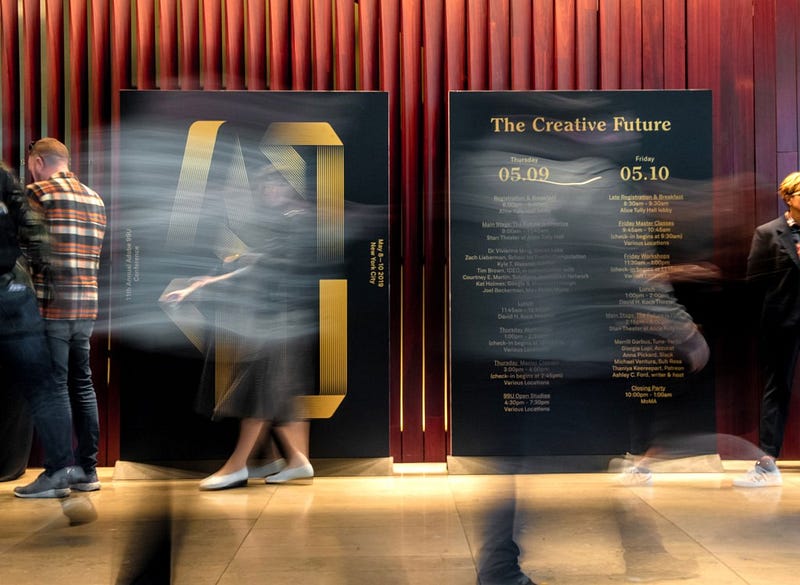
How to make the future bright
Below I share my takeaways of the following two days of keynotes, master classes and workshops that are everything from being entertaining to thought-provoking and inspiring.
Day 1
The first speaker of this year’s 99U is Dr. Vivienne Ming, who co-founded Socos Labs, an independent think tank that explores the future of human potential and the influence of AI on it. Alongside an insight into her latest brainchilds like a technological brain support to stimulate human thinking, she underlines the role of human creativity in the context of the increasing possibilities in the field of AI: In this day and age, it is even more important to be brave enough to truly explore new shores and share one’s unique vision as this will remain an essential advantage of the human being for the foreseeable future. She appeals strongly to our courage — to put it above the fear of losing our jobs if we want to achieve real change.
“Artificial intelligence is fundamentally a tool and you’re the artists. It is a huge mistake to think AI will solve our problems. But taking creative people that know how to explore the unknown and have the courage to do what they think is right, that is fundamentally what creativity is about.”
— Dr. Vivienne Ming, Co-Founder & Executive Chair at Socos Labs
The key message of the next speaker, Zach Lieberman, the co-founder of the School for Poetic Computation that teaches students how to use code as a medium for poetry and art, is to constantly look for opportunities in which we can learn and grow — and help others do the same.
“The key to creativity is finding a way to listen to yourself.”
— Zach Lieberman, Co-founder of School for Poetic Computation

Zach Lieberman is followed by Kyle T. Webster, a Design Evangelist at Adobe. He makes a point stressing how we entertain our minds from morning to night with ever more screen time although boredom is a blessing and a key driver of creativity — a means to unlock the place where creative ideas come from. “We are so bad in being bored. We have to allow ourselves the time and space for boredom. What if we perceive boredom as a blank canvas for our mind?” are some of his central statements.
“We can’t control our subconscious, but we can create the circumstances where our subconscious comes into play.”
— Kyle T. Webster, Design Evangelist at Adobe
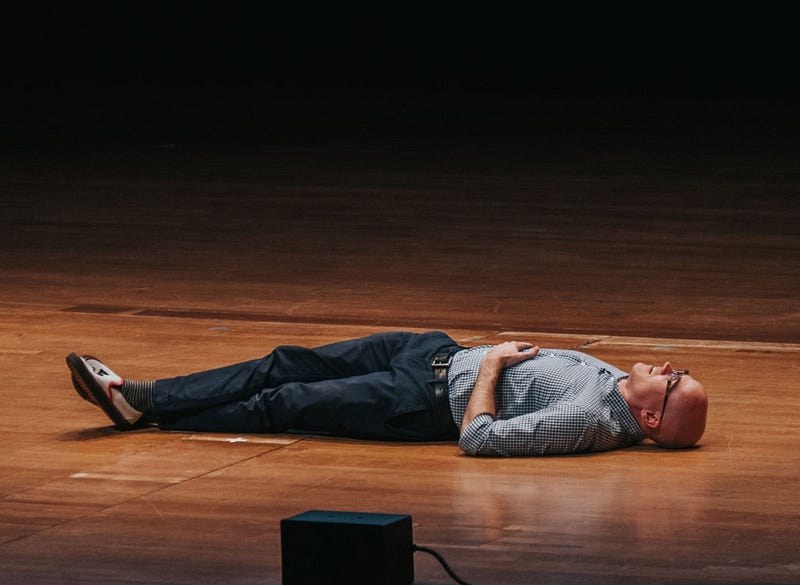
Next, IDEO’s Tim Brown is interviewed by Courtney E. Martin about various design topics. In his opinion, it is the best time in history to be a designer.
Similar to Dr. Ming before, Brown also addresses the necessary creative confidence to go into the unknown as well as the necessity in our times to master the design of evolving products when iteration and a constant management of ecosystems comes into play. You can’t just design products and are done, ready to move on to the next project — there is no finite moment anymore. Speaking about ecosystems, he makes the comparison with natural ecosystems like rainforests that are diverse, complex and ever evolving.
In addition, he talks about that design is a team sport as well as politics. More ideas fail in organizations than from market rejection so that getting a great idea through the maze is equally important as coming up with the idea in the first place. In this respect, he mentions that mastery in design largely means mastering people and organizations. You have to design for the organization that is the vehicle, for example by creating real experiences as soon as possible instead of bland PowerPoint slides.
Towards the end of the interview, Brown speaks about the necessary ethics of design work – at the same time warning that if you only care about not creating any sort of harm for anyone, you will never create something new. “The thing about new ideas is that they’re like a fragile new species. They have to live for awhile before they flourish. If they get killed before that, they don’t have a chance to flourish,” he says. Instead, we need a system or agreement to make sure we don’t do intentional harm.
“That confidence to leap into the unknown is a form of mastery.”
— Tim Brown, CEO & President of IDEO
Kat Holmes, Director UX Design at Google and Founder of Mismatch.design, takes the opportunity to speak about inclusive design and how it can be a catalyst for design as it opens up your thinking. “What if there is no average, no normal?” she asks. She tells us to always ask what is missing in one’s design and what changes for all users when moving from a human to a digital experience for example. “Disability is no health condition but a mismatch — a mismatched interaction between the features of a person’s body and the features of the environment they live in,” Holmes says. “Don’t expect people to match your design. It should be the other way around.”
“What if there was no such thing as normal? How would we proceed in our design?”
— Kat Holmes, Director UX Design at Google & Founder of Mismatch.design
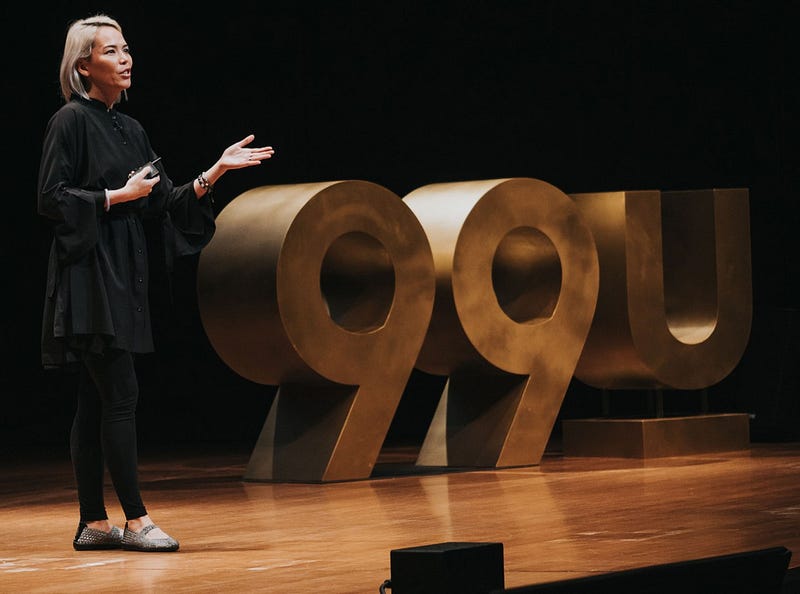
In the following talk, Joel Beckerman, Founder, Composer and Producer at Man Made Music, makes us aware that a lot of designers simply forget about sound although it is the experience dimension to which users respond most quickly. “If you’re afraid of a horror movie, don’t close your eyes, close your ears,” he tells us. Therefore Beckerman encourages us to practice better storytelling by using music and sounds and also to keep in mind the reaction you want to create with an experience in a given environment. Can you imagine the beeping sounds in hospitals to promote health and well-being?
“When the sound doesn’t match the visuals, your brain believes your ears first.”
— Joel Beckerman, Founder, Composer & Producer at Man Made Music
In the afternoon, I attend a high-energy workshop run by Disney’s former Head of Innovation & Creativity, Duncan Wardle.
Following the title ‘Blue Sky Thinking: Where Revolutionary Ideas Come From’, Wardle speaks about how to spark creativity and come up with new ideas as well as how to share them with your team and the client in a sucessful way.
He shares the story behind the Disney MagicBand — a plastic bracelet in use at Walt Disney World Resort that provides a way for the system to connect data to guests. “At the start of its development, the central question was ‘How can we avoid standing in lines?’ and not ‘How can we raise profit by 3%?’” Wardle says. “Start by embedding new solutions deeply in and financial success will follow.”
Speaking about ideation, Wardle encourages us to get into a subconscious state, something that usually doesn’t happen in the office, to encourage playfulness and to regularly break out of our daily habits. Doing things differently every time allows us to access a fresh mind for creative ideas.
Another approach to thinking beyond the usual patterns is the involvement of naive experts — to have an outsider in the room in the form of a person from a different country or industry, who asks the ‘stupid’ questions and brings in new possibilities for solutions. Similarly, he recommends to list all the rules of a challenge and challenge them by asking ‘What if these rules didn’t apply? What would our possibilities be?’.
In an attempt to create an open, positive space for sharing new ideas,
Wardle reminds us of preferring the phrasing ‘Yes, and …’ over the use of
‘No, because …‘ to transfer a concept from ‘my/your idea’ to a group idea and also to grow infant ideas that are still very rough and by no means fully fleshed out yet.
When a new idea is born, Wardle always captures it in a few full sentences right away to avoid not remembering important details the next day.
Presenting the results to clients, he is a big fan of creating an environment with no barriers such as a table as well as of putting the presentation up on all four walls and taking the client for a walk around the room — turning the presentation into a conversation.
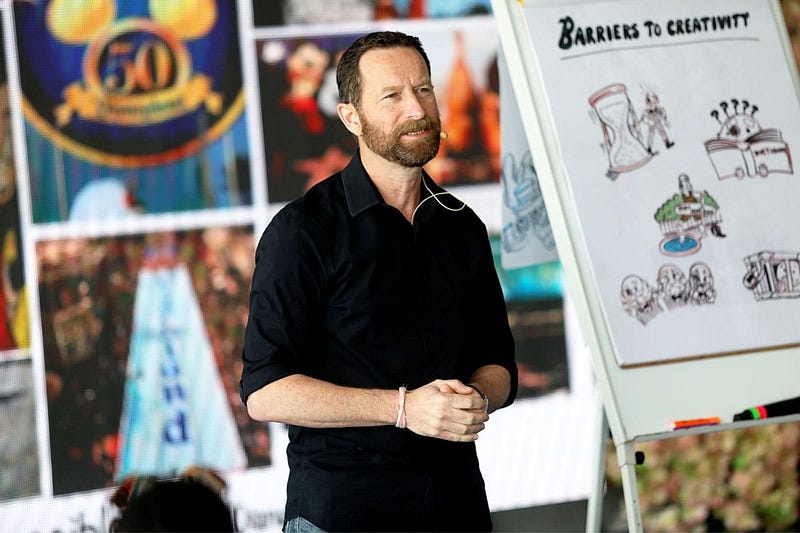

The subsequent master class is entitled ‘Gathering and Presenting Design Research’ and is hosted by Paige Bennett, a Design Researcher at Dropbox.
She shares ways to communicate your research results to turn the larger team into advocates of our findings. “Your findings must be able to live on without you as their guardian,” she says. Exhibit pop ups in central office locations, collaterals like fun stickers with key results as well as an informal ‘brown bag’ Q&A session over lunch or a coffee are all proven formats to get attention and buy-in from people outside of the core research team.
In addition, Bennett suggests to share intentions and results early and continuously during the process, using formats like a ‘What to expect and not to expect’ summary, dispatches from the field, theme progression insights as well as a highlight reel in the end.
Day 2
My second day starts with a master class on ‘Designing Tomorrow, Better’ with Brian Collins. He is the founder of COLLINS that was named as one of the companies transforming the future of brand building by Forbes.
Collins states that “Companies are no longer in competition with each other. They’re in competition with the future itself.” However, we shouldn’t be fighting against the future and all the change it brings, but create a chosen future with maximum love. “The opposite of courage is not cowardice but conformity,” he says.
In this context, he speaks about recent work of his company that attempts to actively shape the future with meaning — engaging Spotify listeners, building a LEED-certified gas station for BP that educates about environmental impact and conservation or a radically new lip balm shape for the skin care brand EOS.
When it comes to execution, Collins mentions the importance of team collaboration as well as courage in visual design that is of particular significance in today’s times in which design finds its way into all processes. ”Create bold design systems that open up possibilities instead of closing them down,” he tells us.

The following workshop on ‘Presenting Bold Ideas’ is held by Irene Pereyrafrom Anton & Irene (Anton is sick that day).
Irene shows us how to prepare for and thrive in any presentation and distills her recommendations down to ten commandments:
- Be comfortable in your body (Relaxation excercises help!)
- Be comfortable with silence (Smile!)
- Be strategic about when you present (Not before or after lunch!)
- Work on your confidence (55% of what is remembered is body language!)
- Get rid of filler words (Choose silence instead!)
- Structure your content like an hourglass (Presenting is storytelling!)
- Learn not to rely on visual aids (Be ready to present without any slide!)
- Practice, practice practice (Practice!)
- Invite feedback from your team (Do they disconnect at ay point?)
- Smile, and learn to enjoy being the center of attention (You rock!)
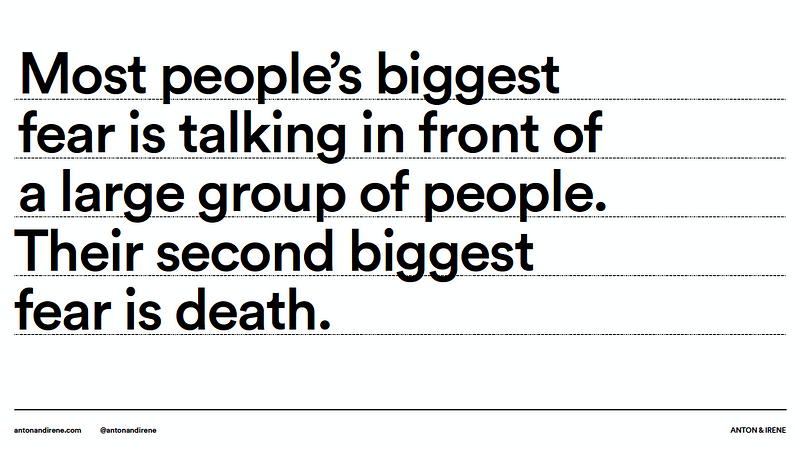
In the afternoon, Giorgia Lupi, Information Designer and Partner at Pentagram, shows us how to make data more consumable and meaningful by the use of design. She is looking forward to a time when data-driven design is replaced by design-driven data. The examples of her work for the ‘Data Wall’ at the Starbucks Reserve Roastery in Milan and for ‘Bruises’ — a project on the impact the illness of a child has on its family — illustrate how data vizualisation has the power to evoke empathy and also personal relevance, especially when music is added for an extra effect. “There is a world of unexplored, small, and intimate data that we never see,” she tells us.
“Our world is random and messy. Collecting data does not make it more perfect or more controllable.”
– Giorgia Lupi, Information Designer & Partner at Pentagram
Next, Anna Pickard from Slack talks about what it means to make your brand human — a goal most brands strive for today. Her key message is to make people feel seen and not to underestimate the value that a heartfelt error message or a “You’re doing great!” tweet might have. “It’s not about pretending to be human; it’s about finding the moments when you can connect with people,” she says. You have to show a two-way empathy, meeting the people where they are, and also bring the people behind the product to the fore. In addition, she tells us to put the voice of the brand in everyone’s hand instead of having a strict guide. In the end, it’s all about being clear, concise and human.
“Words have never mattered more. A single word can elevate something or it can change your perception. Even if it’s just your own perception.”
– Anna Pickard, Head of Brand Communications at Slack
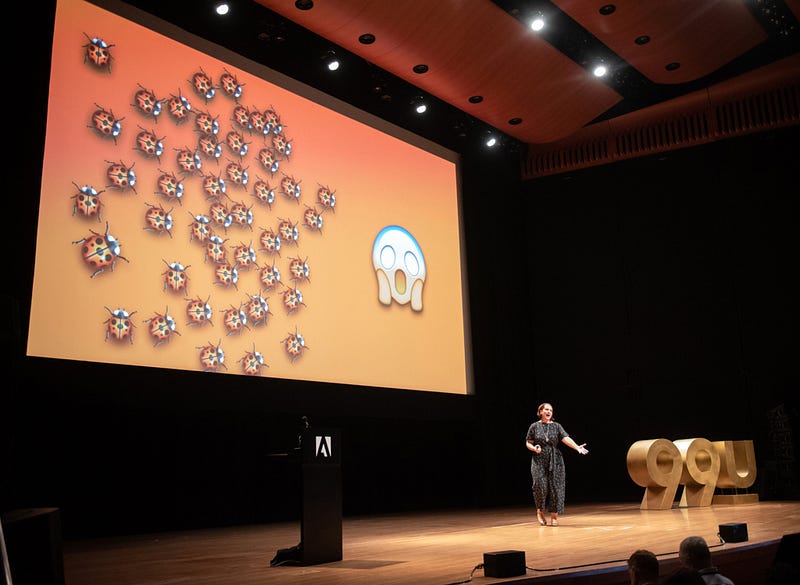
Eventually, Michael Ventura, Founder and CEO of the brand strategy and design practice Sub Rosa, highlights the importance of a holistic empathy throughout teams to make them better at their job. He tells us that empathy goes beyond being nice or compassionate but that it brings versatility to the process, knowing when to ask and when to listen, and that it should be accompanied by the will to really find out new truths. “It’s going to slow things down before it speeds things up,” he says. However, it will show positive results in the form of less rework, more sales as well as happier customers in the long run.
“Empathy requires attention and commitment. Be brave, because this isn’t something everybody’s willing to do. But if you are willing to do it, you will see change.”
— Michael Ventura, Founder & CEO, Sub Rosa
Summary
Looking back on two days full of inspiration, there are several themes and thoughts that were repeatedly addressed or that I particularly remember for other reasons:
Look into the future with a positive state of mind that curiously involves today’s technological developments instead of fighting them and use your capacities that machines can’t imitate so quickly — your unique creative vision as well as the creation of authentic, human relations with consumers.
- Show versatile empathy and find out about the whole self of consumers by practicing deep listening and observation in a trustful setting, meeting them where they are and being open to really discover something new.
- Use the power of your team and create an open, positive and supportive atmosphere where people stimulate each other’s thinking and build on the ideas of other team members to come up with the best results possible.
- Bring out unique ideas by allowing yourself undisturbed time to let your thoughts wander and break out of routines regularly, be bold enough to share your ideas with the world and think of ways that make it easiest for other people to fully understand them.
-
More than ever, creativity today demands courage. Let’s be brave and make the creative future bright by taking control of our tomorrow!
Want to design the future with us?
think moto is a digital design consultancy based in Berlin, Germany.
You are planning an innovation project? Let us know!
You can find us at thinkmoto.com.